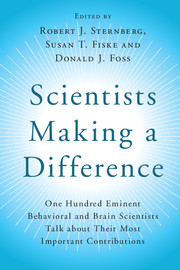 Scientists Making a Difference
Scientists Making a Difference from Section C - Behavioral and Molecular Genetics
Published online by Cambridge University Press: 05 August 2016
In retrospect, after reaching my eighty-fifth birthday and still thinking/writing/editing, I can retrace the paths that resulted in some of my most prominent successes as a behavioral genetics researcher. My childhood curiosity about Nature took the form of collecting leaves, birds’ eggs, and pond water, and really escalated with birthday and Hanukkah gifts of junior microscopes and expansions of starter chemistry sets, supplemented by “innocent” trips to the pharmacy. Before completing elementary school, my mother had to constrain my expertise due to bad smells emanating from the basement as well as the potential self-harm from homemade fireworks.
Fast forward to my undergraduate days at the Illinois Institute of Technology (the MIT of the Midwest), courtesy of an NROTC scholarship during the Korean War, where my curriculum was slightly constrained by a mandatory minor in Naval Science. It took only one course in abnormal psychology for me to switch my major from physics to focus on psychopathology as a way to reconcile my interests. After a three-year interlude as a naval officer during the Korean War, and courtesy of the new G. I. Bill, I was fortunate to be accepted into the scientist-practitioner-model training program in clinical child psychology at the University of Minnesota. Core courses on the psychology of individual differences, taught by Donald G. Paterson and James J. Jenkins, exposed me to the classical twin studies of schizophrenia and other psychoses, with their unambiguous conclusions that hereditary factors play major roles in their distal etiologies (or causes) – unambiguous, that is, to those not bitten by the psychodynamic bug endemic in post-World War II behavioral-science discourse.
Paterson, an eminent psychologist who had shaped cognitive testing for illiterate draftees during World War I and who was an avid civil libertarian, introduced me to his friend in the Department of Zoology, Sheldon C. Reed. The latter was a fruit-fly geneticist whose interests had shifted to humans with mental retardation or psychoses, conceptualized as continuously distributed traits. He had coined the term “genetic counseling,” and it was one of the skills I acquired.
To save this book to your Kindle, first ensure [email protected] is added to your Approved Personal Document E-mail List under your Personal Document Settings on the Manage Your Content and Devices page of your Amazon account. Then enter the ‘name’ part of your Kindle email address below. Find out more about saving to your Kindle.
Note you can select to save to either the @free.kindle.com or @kindle.com variations. ‘@free.kindle.com’ emails are free but can only be saved to your device when it is connected to wi-fi. ‘@kindle.com’ emails can be delivered even when you are not connected to wi-fi, but note that service fees apply.
Find out more about the Kindle Personal Document Service.
To save content items to your account, please confirm that you agree to abide by our usage policies. If this is the first time you use this feature, you will be asked to authorise Cambridge Core to connect with your account. Find out more about saving content to Dropbox.
To save content items to your account, please confirm that you agree to abide by our usage policies. If this is the first time you use this feature, you will be asked to authorise Cambridge Core to connect with your account. Find out more about saving content to Google Drive.